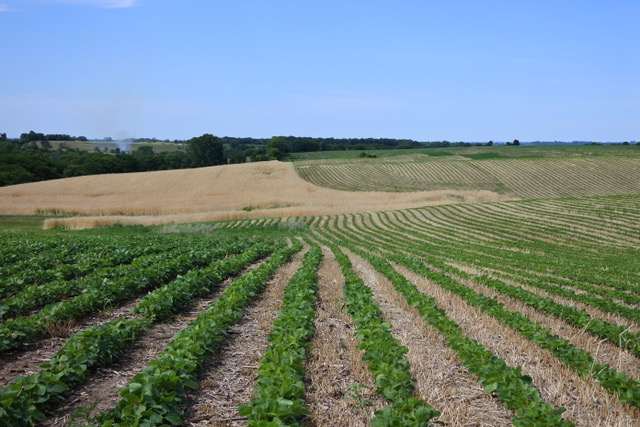The Soil Under Our Feet
When people and organizations have different stakes and challenges within complex systems, how do we help them collectively create change?
The following is taken from an article (reposted from the Presenting Institute) written by Academy co-Founder, Hal Hamilton, and Elizabeth Reaves of the Sustainable Food Lab. You can read the full article here.
This past June, while facilitating a learning journey with a group of 30 young sustainability executives from major food companies, we found ourselves standing under a bluebird Iowa sky gazing out over vast fields of corn. The farm belonged to in Jeremy Gustafson, an Iowa native in his 40’s. Moments earlier, the executives had witnessed a powerful demonstration of the impacts of rainfall on various types of soil. The “rainfall simulator” visually conveyed what happens in fields that are tilled compared to fields with more crop residue on the surface, where soil-building plants such as oats and clovers grow in rotation with corn or soybeans.
Watching the simulator, the group experienced one of those breathless moments of understanding. They saw muddy brown water drain from the tray of conventional tilled corn ground, taking with it the essential nutrients needed for a healthy crop. Then, they witnessed the clear slow drip from the other end of the simulator, on a piece of ground sprouting a thick root mass of bright green oats dug from one of Jeremy’s field. The trickle of clear water signaled that nutrients had remained in the soil and most of the rain had been absorbed.
Holding a journal and pen in her hand, one of the most senior executives on the trip, Sally, turned to Jeremy, the farmer, and asked, “Why is it that you don’t plant more oats and cover crops across the whole farm whenever corn or soybeans aren’t growing?” Just hours earlier, as part of the learning journey, Sally listened to agricultural scientists describe how most of Iowa was bare ground between the cash-crop seasons – roughly eight months of every year.
“Look,” Jeremy said, “I have about 40 crop years in my lifetime. That’s 40 chances to get it right. The risk of not getting it right is terrifying.” Stretching his arms across the corn horizon, he continued, “I am alone out here. I’m the only one of my neighbors who plants cover crops. They don’t just think I’m different; they think I’m passing judgment on the way they farm!”
There was a momentary pause. “As for oats,” he said, “I would love to grow more oats. I grow great corn after oats. And now that we are adding a legume cover crop, I can reduce my fertilizer use by up to 40% in the corn year. But I don’t have anywhere to sell these oats.”
Slowly, Sally closed her journal. She put her pen down. Until this moment, she thought she knew the answer to Jeremy’s dilemma. Farmers, she had assumed, just needed to add soil-building crops between corn or soybean seasons. But Jeremy’s answer made the whole situation more complicated and difficult. Jeremy couldn’t do what he really wanted to do unless he had more support — particularly, in the form of risk sharing and peer-to-peer learning. The clear water from the oat field tray in the simulator was good, Sally realized, but the challenges stacked up against that kind of change were big – perhaps too big for her company, a company that just buys corn.
These can be discouraging moments. Everyone can just see what needs to happen, but then each key player explains the obstacles from their own perspective.
In this case, from the farmer’s (Jeremy’s) point of view, the obstacles include cultural resistance from neighbors and up-front costs and risks, without the security of markets for rotation crops. Farmers cannot bridge this impasse until there is a solution to deal with short-term costs, as well as organized peer support to overcome cultural resistance to change.
The obstacle from the corporate VP’s (Sally’s) point of view is the thinking that “we just buy corn; it’s not our job to help farmers transition by creating markets for rotation crops.” For companies to bridge the impasse, they need to move out of commodity silos to collaborate and create markets for rotations. They need to see themselves as actors in the larger system in addition to just “buying corn.”
From a Sustainable Food Lab point of view, we know that all stakeholders would benefit from a shift in how they operate. Most specialized commodity systems lack diversity, so growing small grains, legumes, and cover crops would build soil organic matter, and increased soil organic matter would create more resilient productivity, improve water quality, and sequester carbon. Farmers like Jeremy would clearly benefit in the long-term, even if there were short-term investments. We also know that companies would, in the long-term, get a more resilient supply of ingredients, and executives like Sally would be able to meet corporate sustainability goals.
But to get to actual change, a lot else needs to happen.
When people and organizations have different stakes and challenges within complex systems, how do we help them collectively create change?

